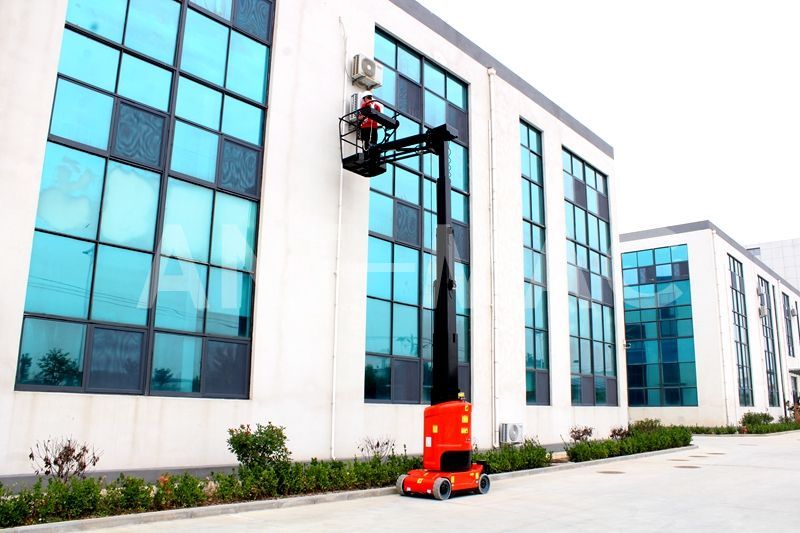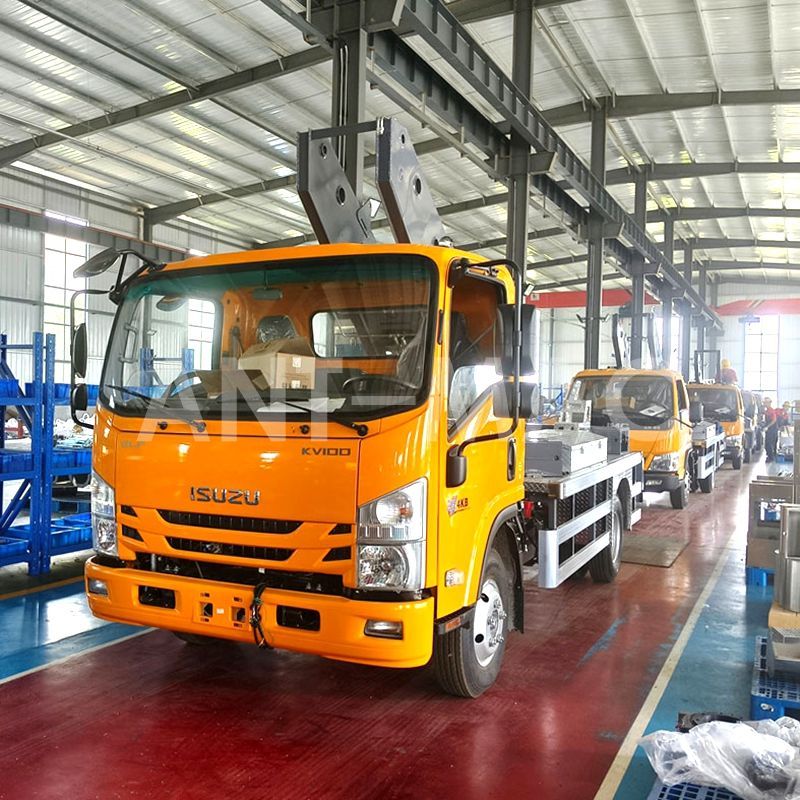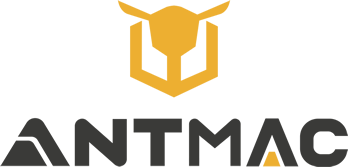
In construction, energy, municipal works, and commercial maintenance, the performance of aerial work equipment directly impacts project quality and operational safety. As a representative of industry technological innovation, the Sleeve Vertical Lifting Platform has emerged as the fastest-growing solution in the market, leveraging its high-strength structural design, intelligent control technology, and full-scenario adaptability. This article dissects the revolutionary advantages of this "aerial work expert" from three dimensions: core performance strengths, technological breakthroughs, and industry value.
I. Structural Innovation: The Perfect Balance of Stability and Flexibility
The mast-type aerial work platform, also referred to as the Sleeve Vertical Lifting Platform, features a high-strength aluminum/steel sleeve nesting structure, expanding working height through vertical lifting of multi-section masts. Compared with traditional scissor lifts, its core advantages include:
Exceptional Stability: The mast design optimizes sleeve eccentricity (≤5mm) and center-of-gravity ratio, achieving wind resistance up to level 10 (24m/s). Platform sway is reduced by 40% compared to conventional models, maintaining stability within ±15mm even at a 14m working height—ideal for high-precision tasks like precision equipment installation and glass curtain wall maintenance.
Compact Space Adaptability: With a width of only 700-1000mm, it easily passes through standard doorframes (800mm) and elevators (load ≤1 ton), making it perfect for narrow spaces in malls, office buildings, subways, and more—solving the "inaccessibility" pain point of traditional equipment.
Rapid Deployment: Requiring no complex assembly, it starts lifting within 30 seconds of power-on. Single-person operation enables quick movement and positioning, saving 50% of preparation time compared to crawler-type equipment.
II. Performance Breakthroughs: Triple Upgrades in Efficiency, Safety, and Intelligence
Efficiency Revolution: From "Time-Consuming Waiting" to "Immediate Operation"
High-Speed Lifting System: Driven by a permanent magnet synchronous motor + planetary gearbox, the Electric Sleeve Vertical Lifting Platform achieves 10m lifting in ≤15 seconds—30% faster than the Hydraulic Sleeve Vertical Lifting Platform. Combined with 345° platform rotation and 0.5m horizontal extension, single-station coverage doubles.
Enhanced Load Capacity: Standard models carry 200-300kg, while customized heavy-duty models exceed 500kg, supporting two operators with tools for heavy-load scenarios like industrial plant equipment hoisting and warehouse shelf maintenance.
Safety Protection: Building a "Proactive + Passive" Dual Assurance System
Proactive Safety Technology: Integrates LiDAR obstacle avoidance (detection range 0.3-5m), weight sensors (auto-stop at 10% overload), and tilt monitoring (≥5° alarm) to prevent collisions, overloads, and tipping from the source. Dual compliance with EU CE and US ANSI A92.20 standards ensures global operational safety.
Passive Protection Design: Full-enclosure guardrails (1.1m height), anti-pinch mast gaps (≤8mm), and emergency descent mechanisms (reaching ground within 30s of power failure), combined with ISO 28000 supply chain safety management, create a "zero-blind-zone" safe working space.
Intelligent Control: Ushering in the Era of "Precision Operation"
Upgraded Human-Machine Interaction: A 7-inch touchscreen integrates fault diagnosis, height setting, and power management, supporting Chinese-English switching and gesture operations. Wireless remote controls function up to 50m, allowing operators to remotely control movement, lifting, and rotation from safe zones.
Data-Driven Maintenance Support: Real-time equipment status (working hours, fault codes, battery life) is uploaded via IoT modules. Cloud management platforms generate maintenance reports and push service reminders, reducing downtime by 60% and maintenance costs by 40%.
III. Full-Scenario Adaptability: All-Round Applications from Commercial Refinement to Industrial Heavy-Duty
The mast-type platform's performance advantages make the Sleeve Vertical Lifting Platform the preferred choice across industries:
Commercial Scenarios: For mall ceiling maintenance or hotel curtain wall cleaning, the Electric Sleeve Vertical Lifting Platform’s silent drive (noise ≤65dB) and non-marking tires avoid disrupting public operations. A minimum height of 1.2m allows access to ceiling interlayers, solving "hard-to-reach" aerial blind spots untouched by traditional equipment.
Industrial Scenarios: In wind turbine tower maintenance (adapting to -20℃~50℃ temperature differences) and petrochemical pipeline maintenance (explosion-proof models available), the Hydraulic Sleeve Vertical Lifting Platform offers robust performance with IP54 protection rating and anti-corrosion coating (1000-hour salt spray resistance), ensuring stable operation in harsh environments, extending service life by 25% compared to similar equipment.
Municipal Projects: For streetlight maintenance or bridge crack detection, the platform can be vehicle-mounted for rapid relocation. With GPS positioning and electronic fence functions, it meets the digital management requirements of government projects.
IV. Industry Value: Redefining the Aerial Work "ROI"
According to the 2024 Global Aerial Work Equipment Market Report, the Sleeve Vertical Lifting Platform market grows at 18% annually—far exceeding the industry average. Its core competitiveness lies in:
Cost Optimization: Electric models consume only 1/3 the energy of diesel equipment, eliminating hydraulic oil replacement and engine maintenance costs—reducing annual usage costs by 50%. Modular mast design cuts single-section replacement costs by 70% compared to overall repairs.
Efficiency Enhancement: A case study in an automobile factory shows the mast-type platform boosts construction efficiency 8x compared to scaffolding. With a silent night operation mode, it enables 24/7 continuous construction, shortening project cycles by 30%.
Green Transition: Zero-emission electric drive and recyclable aluminum materials (95% recycling rate) align with global "dual-carbon" goals, reducing equipment carbon footprint by 80% compared to traditional fuel models—making it a priority for government green procurement lists.
Conclusion: Mast-Type Platforms Leading the Aerial Work Equipment 3.0 Era
From "functional" to "user-friendly" and now to "efficient + safe + intelligent," the Sleeve Vertical Lifting Platform—encompassing both the Electric Sleeve Vertical Lifting Platform and Hydraulic Sleeve Vertical Lifting Platform—is redefining industry standards through technological innovation. With the deepening application of 5G remote control and self-diagnostic maintenance, this "aerial work magic tool" will further break through height and scenario limitations, serving as critical equipment support for national strategies like construction industrialization, urban renewal, and new energy development. In an era where efficiency and safety go hand in hand, the mast-type platform is not just a device but a tangible endorsement of project quality and enterprise competitiveness.
 Dual-Chain Telescopic Boom Sys
Dual-Chain Telescopic Boom Sys
 Russian
Russian
